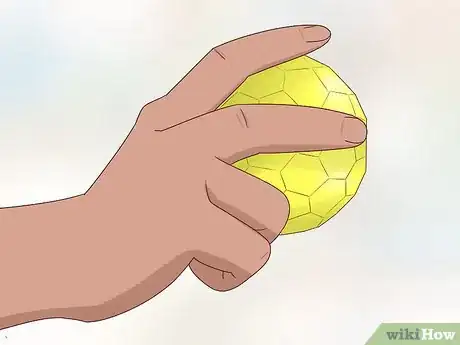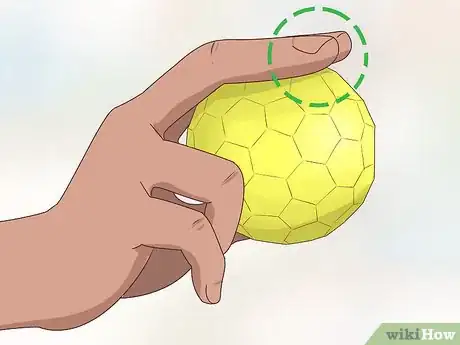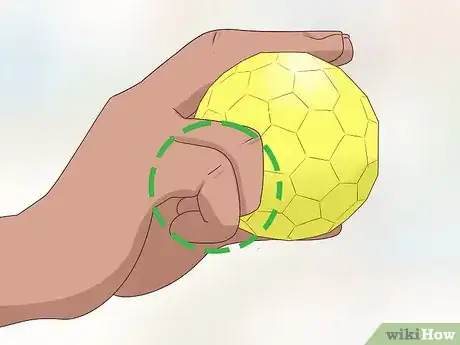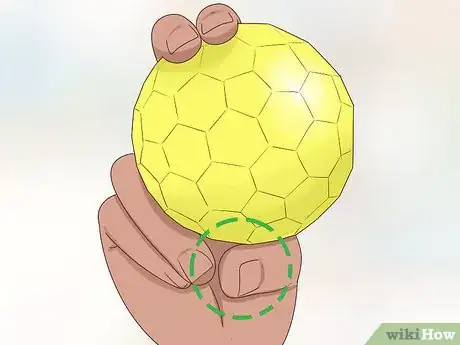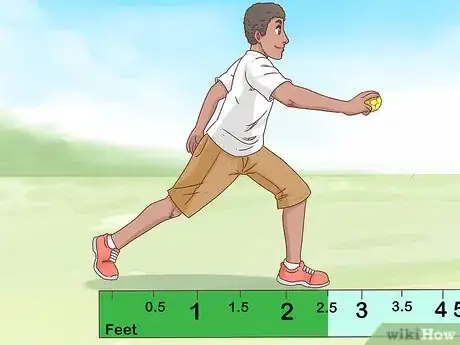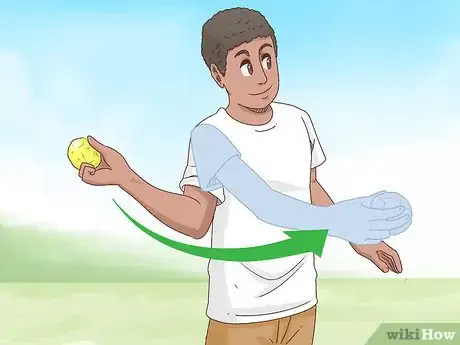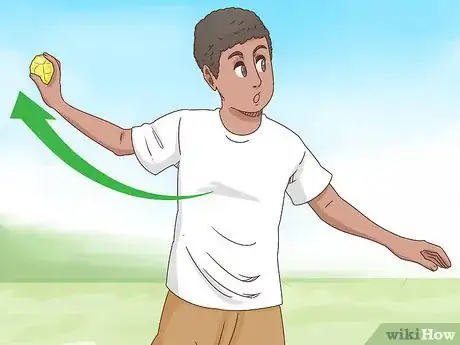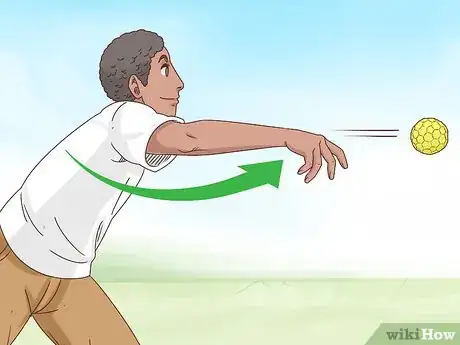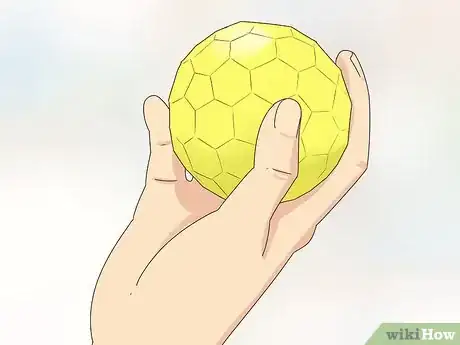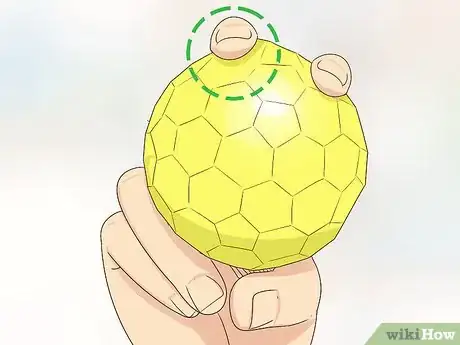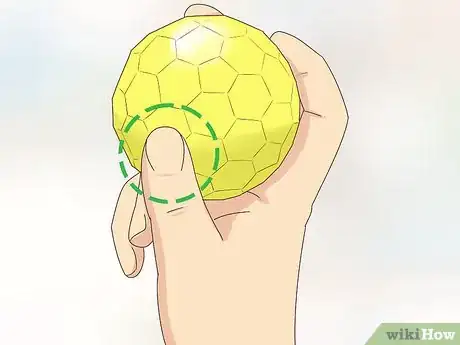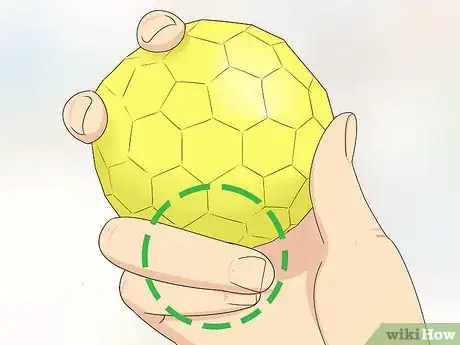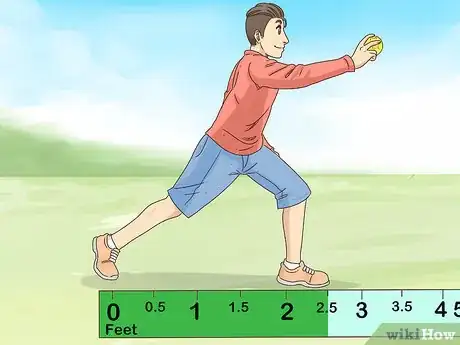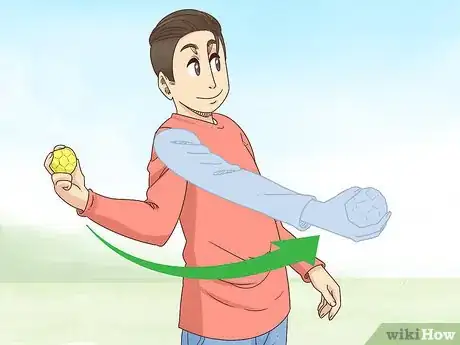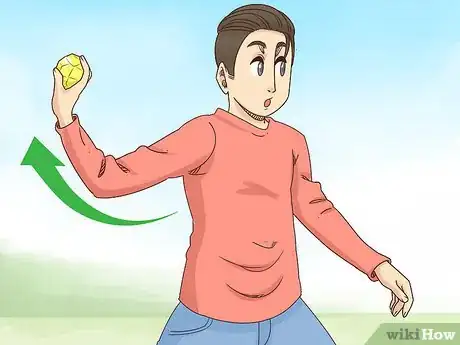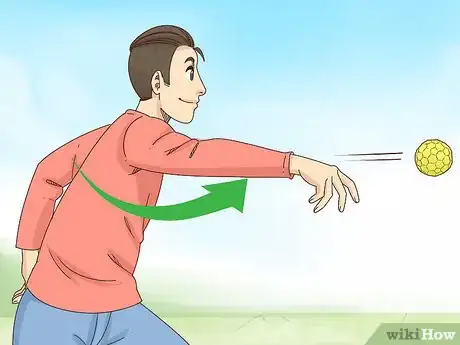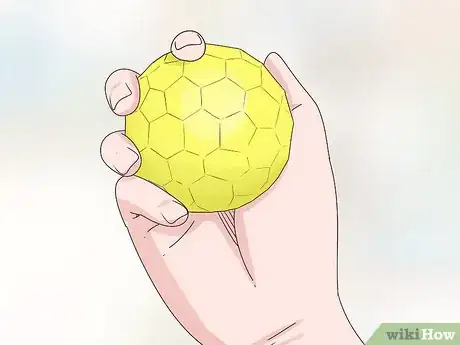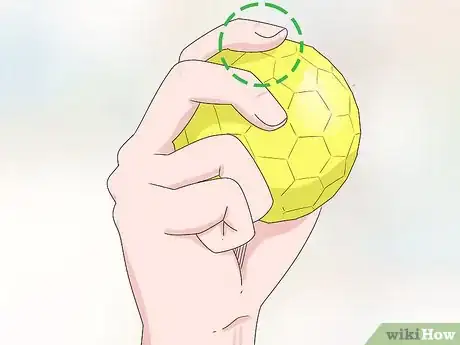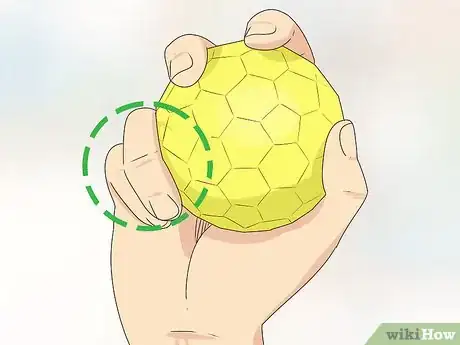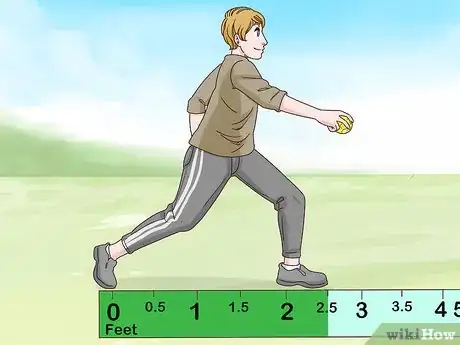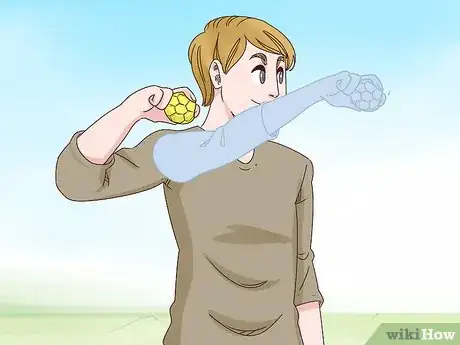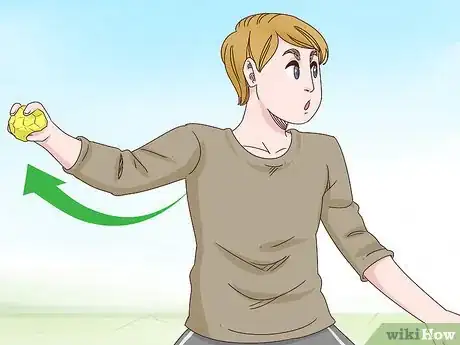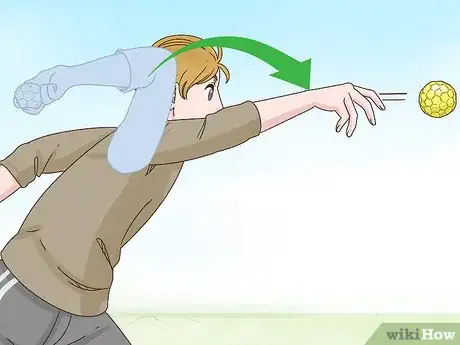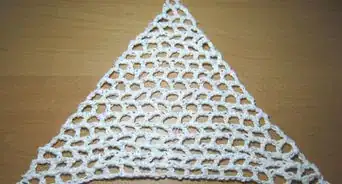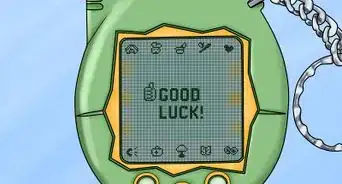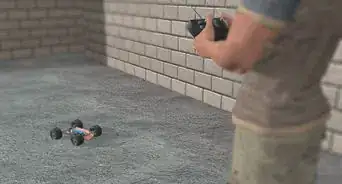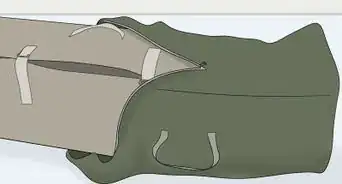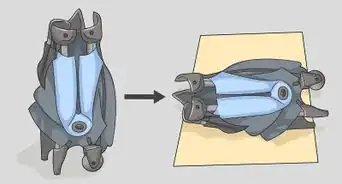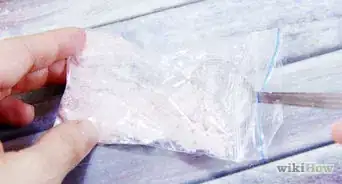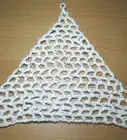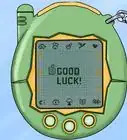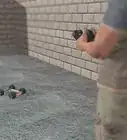This article was co-authored by wikiHow Staff. Our trained team of editors and researchers validate articles for accuracy and comprehensiveness. wikiHow's Content Management Team carefully monitors the work from our editorial staff to ensure that each article is backed by trusted research and meets our high quality standards.
This article has been viewed 31,347 times.
Learn more...
Blitzball is a fun backyard version of baseball. You can quickly improve your game by learning different kinds of throws. A slider is one of the easiest throws to make and is a good first throw to learn. The 2-seam fastball is a quick and accurate with throw. The screwball is a slightly harder throw as you need to turn your wrist as you make the throw. Once mastered, the screwball is an impressive throw that can have plenty of spin. The different throws have similar techniques but the different grips and arm movements will produce unique results.
Steps
Throwing a Slider
-
1Hold the ball tightly in your hand. Grip the ball in your dominant hand or the hand you normally throw with. Push the ball into your palm and wrap your fingers around the ball.
-
2Place your index and middle fingers over the top seam of the ball. Position your fingers close together so that they are lightly touching each other. Wrap them over the ball so that they follow the curve of the seam.
- Practice picking up the ball and bringing your fingers to the correct position. The more you practice the quicker this process will become.
Advertisement -
3Rest your other fingers to the side of the ball. Support the ball with the side of your ring finger. Use your thumb and index/middle finger to provide the primary grip of the ball, this ensures that the throw will go in the correct direction.
- Keep bending your ring finger and pinky until you find a position that is comfortable for you.
-
4Hold your thumb slightly towards the outside of the ball. Position your thumb so that it sits on the outer side of the bottom seam. Don’t press your thumb flat onto the ball, let the ball rest on one side of the thumb.
- Experiment with the positioning of your thumb in relation to the bottom seam. You will find that different positions will give different angles to your throw.
-
5Step forward with your opposite foot. Bring your foot that is on the opposite side of your body to the hand that's holding the ball about 2.5 feet (0.76 m) forward. Make sure that your toes are pointing forward in the direction that you want the ball to go. This position will allow you to turn your body towards your throwing hand to help you gain momentum in your throw.
- As you become more confident with the throw, try stepping forward at the same time as you are throwing the ball.[1]
-
6Bring your forearm out to the side so that it forms right angles with your body. Lift your forearm so that the inside of your wrist faces the direction that you want the ball to go. Point the open face of the ball towards your target.
- Keep your hand and forearm parallel to the ground to ensure that the ball goes straight. [2]
-
7Pull your forearm back behind your body. Bring your arm back behind your body to a position that feels comfortable. Keep your forearm parallel to the ground so that the ball flies straight.
- If you find that your throws lack momentum, try pulling your forearm further behind your body.
-
8Release the ball as you push it forward past your body. Quickly bring your arm forward and release the ball slightly after your hand moves past the line of your body. Roll the ball off your index finger as you make the throw.
- Avoid snapping your wrist as you make the throw.
Delivering a 2-Seam Fastball
-
1Grip the ball in your hand. Hold the ball in your dominant hand or the hand you normally throw with. Tuck the ball into your palm and tighten your fingers around the ball.
-
2Place your index or middle finger on the top seam of the ball. Position your finger so that it is over the seam and follows the curve down the ball. Rest your other finger about a finger width from the seam. Grip both fingers around the ball using even strength.
- Experiment with both of your fingers and find out which one is more comfortable for you.
- Practice picking up the ball and bringing your fingers to the correct position. The more you practice the quicker this process will become.
-
3Hold your thumb on the bottom seam of the ball. Position your thumb so that it over the bottom seam. Press your thumb flat onto the ball so that you are holding the ball securely in place.
-
4Use your ring finger to support the side of the ball. Rest your fingers to the side of the ball. Keep bending your ring finger and pinky until you find a position that is comfortable for you.
- Use your thumb and index/middle finger to provide the primary grip of the ball, this ensures that the throw will go in the correct direction.
-
5Bring your opposite foot about 2.5 feet (0.76 m) forward. Point the toes of the foot opposite your throwing hand forward, facing in the direction that you want the ball to go. Slightly turn your body towards your throwing hand to help you gain momentum in your throw.
- Try stepping forward at the same time as you are throwing the ball.[3]
-
6Bring your forearm out to the side of your body. Position your forearm so that it is horizontal and perpendicular to your body. Lift your forearm so that the inside of your wrist faces the direction that you want the ball to go. Direct the open face of the ball towards your target.
- Keep your hand and forearm parallel to the ground to ensure that the ball goes straight. [4]
-
7Move your forearm back so that is slightly behind your body. Bring your arm back behind your body to a position that feels comfortable. Keep your forearm level parallel to the ground, even though you have pulled it backward.
- If you find that your throws lack momentum, try pulling your forearm further behind your body.
-
8Push the ball forward and release it once it moves past your torso. Quickly propel your arm forward towards the target. Release the ball as your hand moves past the line with your body.
- Avoid snapping your wrist as you make the throw.
- If the ball isn’t going in the right direction, check to make sure that you are rolling the ball off your index finger and the index finger side of your thumb as you release it.
Pitching a Screwballl
-
1Secure the ball in your hand. Grip the ball in your dominant hand or the hand you normally throw with. Hold the ball in your palm and wrap your fingers around the ball.
-
2Place your index or middle finger on the top seam of the ball. Position your finger so that it is over the seam and follows the curve of the ball. Rest your other finger about a finger width from the seam.
- Experiment with both of your fingers and find out which one is more comfortable for you.
- Practice picking up the ball and bringing your fingers to the correct position. The more you practice the quicker this process will become.[5]
-
3Place your other fingers to the side of the ball. Use the side of your ring finger to help hold the ball in place. Use your thumb and index/middle finger to provide the primary grip of the ball, this ensures that the throw will go in the correct direction.
- Keep bending your ring finger and pinky until you find a position that is comfortable for you.
-
4Move your opposite foot about 2.5 feet (0.76 m) forward. Adjust the position of the toes on the foot opposite your throwing hand so that they are pointing forward in the direction that you want the ball to go. Turn your hips towards your throwing hand to increase the power of your throw.
-
5Hold the ball close to your shoulder and push your elbow out behind you. Place the ball between your ear and your shoulder, but not directly touching them. Position your elbow into a comfortable position slightly behind your shoulder.[6]
- Don't bring your elbow too far behind your shoulder as this will limit the power of your throw.
-
6Stretch out your arm to the side as you release the ball. Extend your arm and sweep it in a circular motion towards your opposite shoulder. The faster you do this the quicker the ball will fly.[7]
-
7Turn your wrist as you release the ball. As you bring your arm forward to release to release the ball, turn your hand so that it goes from being behind the ball to on top of the ball. Release the ball as your hand is pushing forward towards your target.
- Experiment with releasing the ball at different times if you find that the ball isn’t going in the direction that you want it to.
- If you are getting a lot of spin on your ball you will need to release the ball slightly earlier.[8]
